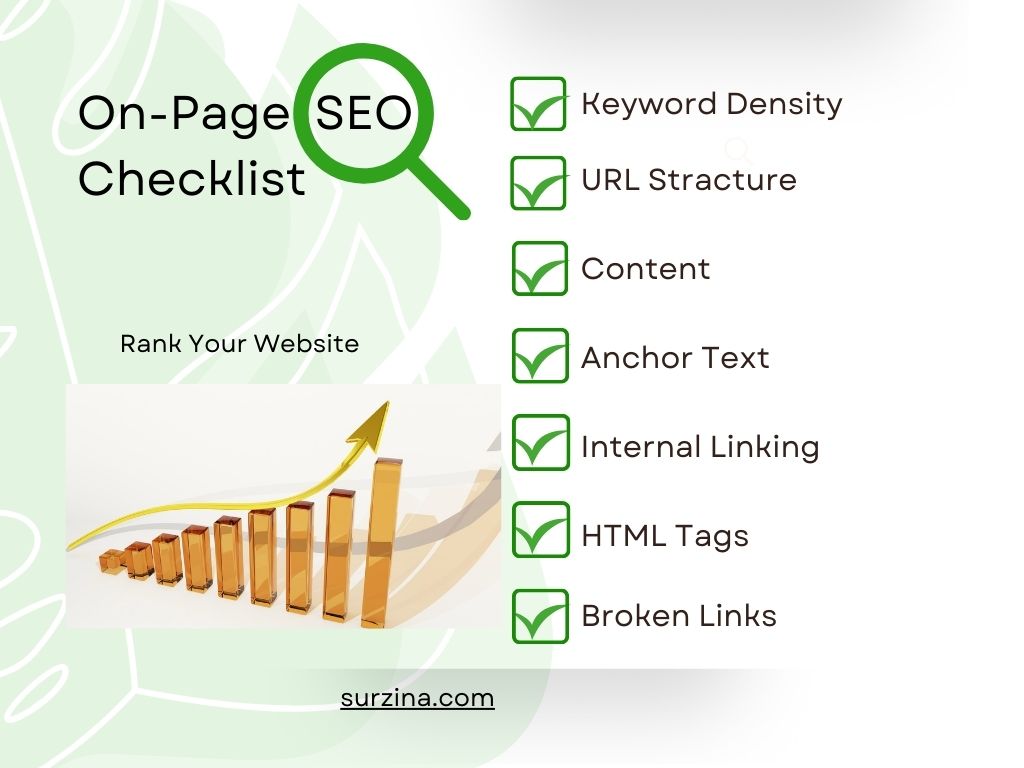On-Page SEO
It is always emphasized by search engines that an increase in ratings as well as provision of the websites with quality and friendly experiences is vital. At this juncture, provided are services related to search engine optimization including an essential component which is the on-page aspects. Within this full guide, we will examine why on-page optimization is important; its advantages and how you can use it for better rankings plus more traffic to your site
What is On-Page SEO?
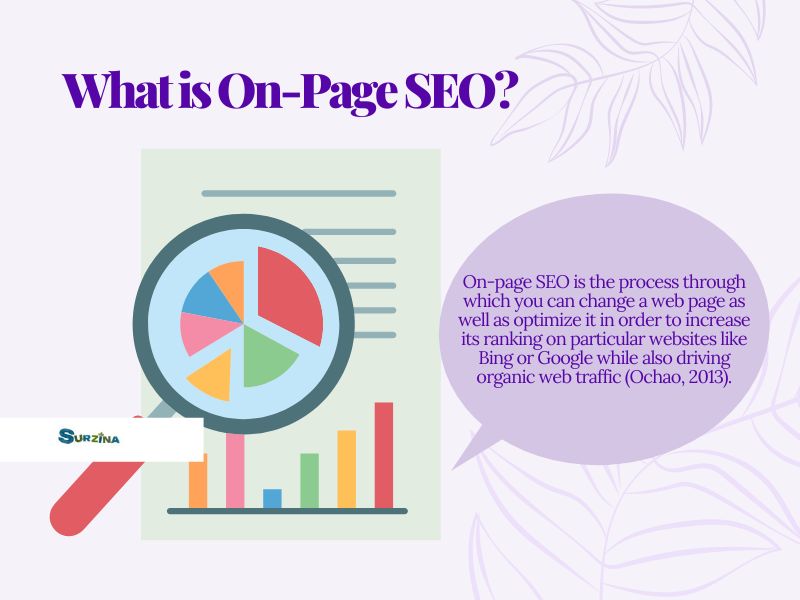
On-page SEO is the process through which you can change a web page as well as optimize it in order to increase its ranking on particular websites like Bing or Google while also driving organic web traffic (Ochao, 2013). To make information on Web pages more searchable both for people using them themselves and for computers trying to find it through various search engines, there exists a specific method that works equally well for both – improving quality of content as well as HTML source code present within individual web pages. Contrary to off-page SEO, which includes such things as link-building and social media activity,
Elements of On-Page SEO
Header Tags
Header tags are those bits of code you use to tell the browser where the stuff you typed in the content section falls in the category of paragraphs or lines. These help search engines figure out what’s most important in the article you give them to read.
Keywords
Including relevant keywords in your on-page SEO makes it easier for search engines to understand your content’s topic and how it relates to search inquiries amongst users.Meta description, body content,headers etc.
Title Tag
A title tag is an HTML element that identifies a page on your website. It appears in search engine results as a clickable title for a targeted result.
Content Quality
The on-page backbone lies in high-quality texts which are unique and informative. By developing content that is useful to people and contains keywords you aim at ranking better in search engines for your website.
Image Optimization
When it comes to enhancing photos to better suit search engine optimization, you should do things such as decreasing their sizes, giving proper names based on common keywords used to find them online and filling out alt tags which denote what each picture actually represents.
URL Structure
For both search engines and users, a well-made URL is very important. It needs to be short, descriptive, and include target keywords.
Meta Description
A short explanation of what each webpage is about which is found below its title on search engine results page is known as metadata description. This enables individuals make decisions on which links they should click on after keying relevant terms into a search engine box.
Page Speed
Fast page load time is key to a positive user experience, search engine optimization and as an important criterion in website ranking; a study has shown how optimizing the speed of your website will also help improve its SEO.
Internal linking
Internal links tie different pages with your website together and aid users in site navigation and helps search engines to navigate and index your content.
Mobile Friendliness
It is necessary to have a mobile-friendly website nowadays because most people use smartphones to access top websites across the globe. Thus, users experience a seamless browsing regardless of their device.
Benefits of On-Page SEO
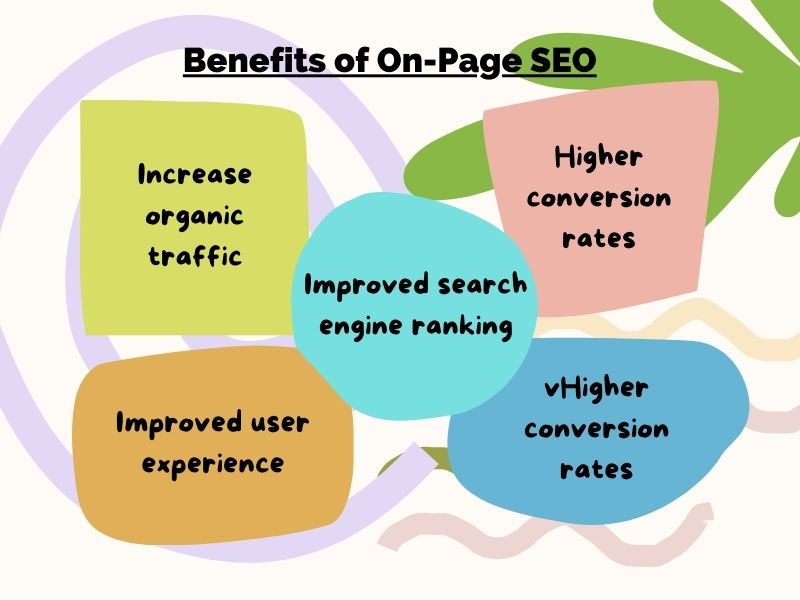
1.Improved search engine ranking
Effective on-page optimization helps search engines better understand your website's content and its relevance to users' search queries. This increases the chances of your web pages ranking higher in the SERPs, which ultimately leads to more organic traffic.
2.Increase organic traffic
Higher search engine rankings and an improved user experience result in increased organic traffic. Users are more likely to click on the top results in the SERPs, and a well-optimized website grabs their attention and encourages them to explore the site further.
3.Improved user experience
Optimizing your web pages for on-page also improves user experience. A well-structured website with high-quality content, fast-loading pages and mobile-friendly design provides a seamless browsing experience for users, resulting in increased user engagement and lower bounce rates.
4.Higher conversion rates
A well-optimized website with relevant content and an engaging user experience encourages users to take action, such as making a purchase, signing up for a newsletter or contacting your business. This helps you achieve higher confabulation rates and increased profits.
5.Long-term results
Unlike paid advertising, on-page offers long-term results in search engines. Once your website pages are optimized and start ranking higher in search engine results pages (SERPs), they continue to generate organic traffic and leads for your business over an extended period of time.
Optimize your website for on-page
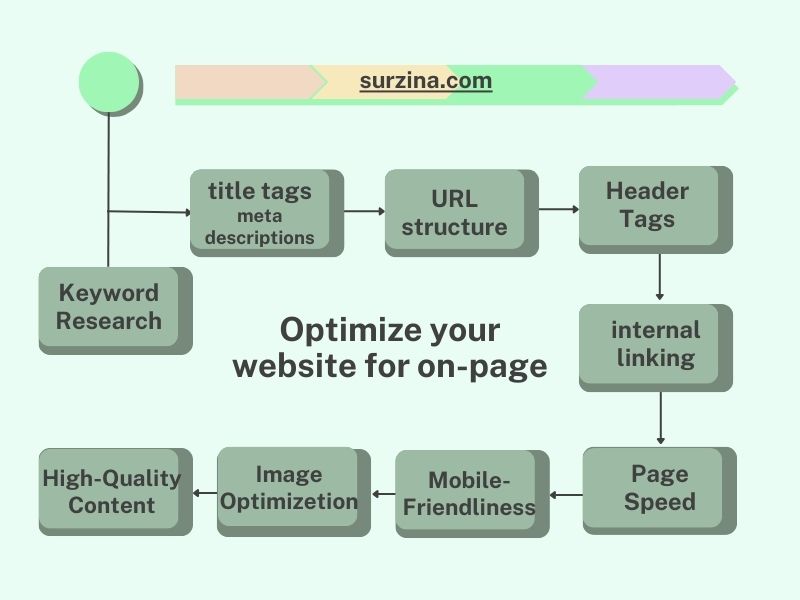
1.Conduct keyword research
Identify the most relevant keywords for your website using your industry research, competitor website analysis, and keyword research tools Include these keywords in your content, title tags, and meta descriptions.
2.Optimize title tags and meta descriptions
Higher search engine rankings and an improved user experience result in increased organic traffic. Users are more likely to click on the top results in the SERPs, and a well-optimized website grabs their attention and encourages them to explore the site further.
3.Use header tags effectively
Use header tags (H1, H2, H3, etc.) to structure your content in a way that is easy for both users and search engines to understand. Include your target keywords within this tag for added SEO value.
4.Optimize your URL structure
Create descriptive and short URLs that include your target keywords. Use hyphens to separate words and avoid using special characters or numbers that can make your URLs difficult to read.
5.Improve internal linking
Include internal links in your content to connect different pages of your website. This helps users navigate your site more easily and allows search engines to crawl and index your content more efficiently.
6.Increase page speed
In order to improve page speed, compress images and minify code, utilize browser cache and take advantage of a content delivery network (CDN) for your website's page speed optimization. Remember for better user experience with more traffic from search engines as an increased page rank.
7.Improve mobile-friendliness
Increase mobile replication, Optimize your website for mobiles. In optimizing images page speed on your site, you will not only make it faster but also increase the search engine relevance of those graphics.
8.Optimize the image
Reduce image size,Use shorter file names and alt texts for images while also making them mobile compatible so that they can load faster on web pages thereby increasing their page speed and providing useful information to search engines.
9.Create high-quality content
Produce a top quality content which could be able to involve the audience in an entertaining, informative but problem solving way using your keywords. In order to enhance your website’s search engine ranking, one of the on-page optimization necessities is quality content writing.
Monitor and analyze your on-page SEO performance
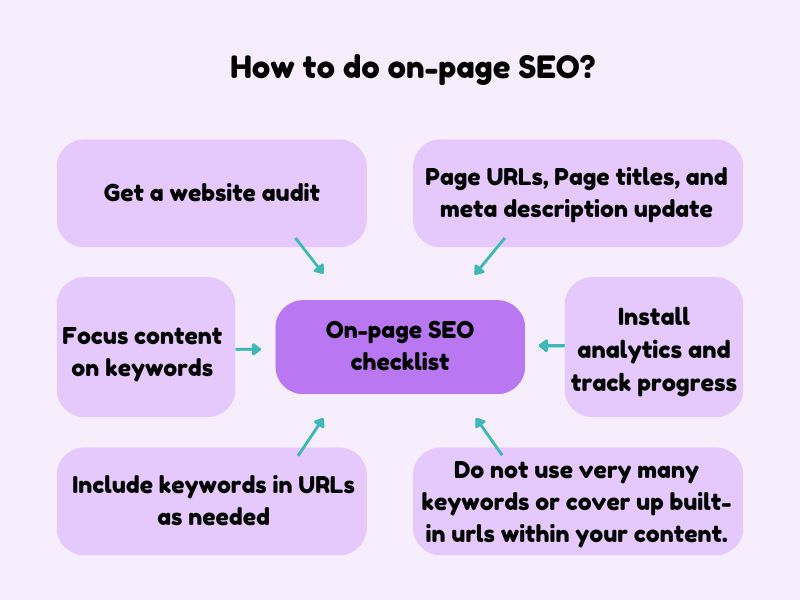
Keep track of how your on-page SEO is doing and examine this in detail. This is best done by using an analytics tool that will help you monitor all of your activities on-site so that way they can be adjusted if need be or further developed in order optimize the website even more effectively. Maintaining this kind of discipline will increase traffic levels significantly over time without any additional effort, other than making adjustments where required whenever necessary.
How to get started On-Page SEO?
To begin on-page SEO, a professional should be hired, as it is the premiere step of starting on-page SEO. This is to ensure that no one misses any item on the SEO checklist. Besides that, it would also help if you have someone who can help improve your website’s SEO through keyword research as well as content optimization among other web development practices.
How to do on-page SEO?
On-page SEO is to follow the on-page SEO checklist
- Get a website audit
- Page URLs, Page titles, and meta description update
- Include keywords in URLs as needed
- Focus content on keywords
- Install analytics and track progress
- Do not use very many keywords or cover up built-in urls within your content.
You could even employ our services for on page seo in order to have a successful project.
How can enhance on-page SEO?
To enhance your on-page SEO, you should perform an on-page SEO audit. This way, you can identify the keywords for which you would like to be ranked, and those that should be in your content. You should also ensure that there’s no need of changing the URL, however if it does, such should not miss including the keyword.
Why is on-page SEO optimization important?
On-page optimization is necessary because your site must attract individuals along with search engines. Enhancing page SEO indicates building pages which unambiguously explain your company and its goals as well as benefit your site. Occasionally, you may struggle to get such solutions at your place while others view it as an opportunity to hire others.
For successful online marketing, it is key to have on-page SEO. This article will offer advice on how one can effectively utilize these methods so as to increase customer satisfaction hence enhancing their chance of appearing at the top of search engine results pages (SERP). With this you will have better visibility on SERPs, and more visitors will come without paying for advertisement or outsourcing.

